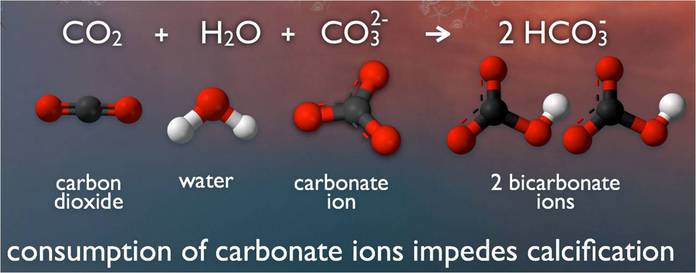More reasons to worry about our food supply tied into the long-term health of our oceans (rivers, of course, too). Changing the chemical balance of any collection of animal and plant material--including man--is dangerous. It is hard to ask sea animals, ocean, Mother Nature to adopt to massive degradation of their supply source and ecological foundation.
There is no global economy without natural resources. Can we afford to further erode the key components of our life lines?

Ocean Acidification to Lead the Way for Food Chain Changes
Phytoplankton’s role in the marine food chain is particularly significant. Phytoplankton, which are microscopic marine plants, form the foundation of the marine food web and regulate key biogeochemical processes. In a balanced ecosystem, phytoplankton provide food for a wide range of sea creatures, including whales, shrimp, snails and jellyfish.
“Because phytoplankton types are not physiologically interchangeable, changing which species are most common in a community can impact the cycling of elements, the flow of nutrients and energy through the marine food web,” Morris, assistant professor in UAB’s College of Arts and Sciences Department of Biology, said. “The implications could be substantial.”
While phytoplankton are extremely crucial to the marine ecosystem, these organisms face multiple environmental changes, including the decline in ocean pH, also known as ocean acidification, caused by rising atmospheric pCO2.
The world’s oceans have absorbed about 30 percent of fossil fuel carbon emissions caused by human activity, resulting in a significant decrease in surface ocean pH. Concerns over the impacts of ocean acidification on marine life have led to a number of laboratory and field experiments examining the response of marine life to acidification.
Morris’ research analyzed published experimental data that assessed growth rates of different phytoplankton populations under typical and elevated pCO2 levels. The data showed a wide variety of responses. Morris, along with collaborators at MIT and Columbia University, then took the effect of ocean acidification on the different populations and studied it within the context of a global marine ecosystem to explore how marine phytoplankton communities might be impacted over the course of a hypothetical 21st century, from 2000 to 2100.
The model ocean changes through the 21st century included warming waters, decreased macronutrient supply, altered light environments, lower pH and increased pCO2 — approximately 0.3 pH units lower and thus twice as acidic. By 2100, temperatures and nutrient conditions were shifted latitudinally relative to 2000, but pCO2 was substantially altered everywhere in the open ocean. Morris’ research focused on global changes to phytoplankton community structure and biogeography as a result of the ocean alterations.
The research found that different types of phytoplankton responded to the alterations in different ways — some populations grew faster in the future and others grew slower, but all phytoplankton groups were altered in some manner.
“One of the striking things about this work is it shows that all phytoplankton groups will be affected by ocean acidification — not just the groups that make calcium carbonate shells, like those you see on corals, which is what researchers have traditionally assumed,” Morris said.
In all, the results emphasized that the differing responses to elevated pCO2 caused sufficient changes in competitive fitness between phytoplankton types to significantly alter community structure.
Acidification specifically had a greater impact on the populations than warming or reduced nutrient supply did.
Morris’ research shows that the phytoplankton community will look different by 2100, which in turn will impact the structure of the marine ecosystem as a whole.
“We now know that the structure of phytoplankton populations will morph in the future,” Morris said. “Further research will help us determine how that shift will alter other marine life that depend on phytoplankton for survival, and the marine ecosystem in its entirety.”
About UAB
Known for its innovative and interdisciplinary approach to education at both the graduate and undergraduate levels, the University of Alabama at Birmingham is an internationally renowned research university and academic medical center and the state of Alabama’s largest employer, with some 23,000 employees and an economic impact exceeding $5 billion annually on the state. The five pillars of UAB’s mission include education, research, patient care, community service and economic development.

No comments:
Post a Comment